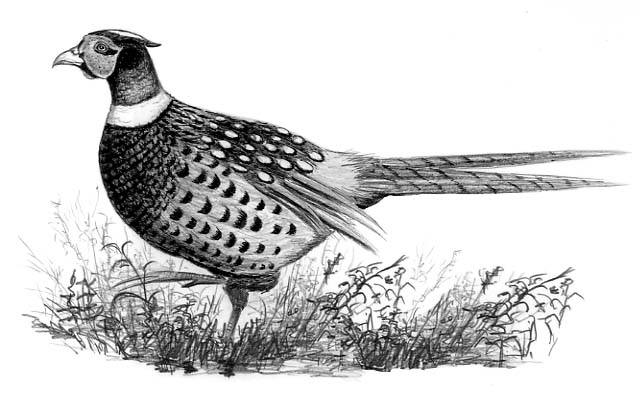
Dear Bird Folks,
When I was a kid one of my favorite birds to see and hear was the Ring-necked Pheasant. I used to love to hear their raucous calls in the spring or watch the handsome males run through my neighbor’s fields in the fall. To me they were the all American bird. Now that I’m grown up, I’m finding out that many of the things that I enjoyed as a kid were not exactly what I thought they were. The Ring-necked Pheasant is one of those disappointments. I’ve just heard that this wonderful bird of my youth is an import, not an American bird at all. Is this true?
-Roy, Reading, PA
Sorry Roy,
Sorry to hear that you’ve “grown up.” That must be an awful thing to have happen. What’s it like? Do you have to eat with your elbows off the table, use a napkin and not talk when your mouth is full. Please don’t tell me that you aren’t allowed to talk when your mouth is full. I couldn’t handle that. Eating vs. talking. I might starve if I had to choose one over the other. This grownup thing has me worried. I hope it’s not contagious.
Now the bad news for you. The Ring-necked Pheasant is, indeed, another import. It is no different than the stuff you find on the shelves of the big discount stores; both come from Asia. While the jamming of our store shelves with imported goods is a fairly recent phenomenon, the importing of pheasants is not. The introduced pheasant has been happily living in North America for well over 100 years. Although, the word “happily” may not be accurate. More on that in a minute.
It’s hard to find any introduced creature that hasn’t caused its share of problems. The House Sparrow, the European Starling, and even the beautiful Mute Swan, are all imports and have all been environmental nightmares. So what about the pheasant? Well, surprise, surprise, the Ring-necked Pheasant has been a very polite guest. It hasn’t eaten other birds, stolen their babies, taken over their nest sites or talked with its mouth full. They have somehow fit into our ecosystem.
When I say “our ecosystem,” I’m referring to the ecosystem that we have imposed on North America. The birds thrived on the food and shelter that were created by the small farms that have always dotted this country. Pheasants lived in the hedge rows between the farms, ate the farmer’s waste grains, devoured lots of nasty insects and occasionally helped out with the chores.
The well marked Ring-necked Pheasant certainly is an eye catcher. It’s easy to understand why people would want to drag them over from Asia. If anyone doesn’t have a clear image of what this bird looks like, they should grab their most recent copy of “Pheasant Weekly” and take a good look at this stately bird. Looking totally overdressed for a cornfield, the distinctive male has a shiny greenish head, a distinct red patch around the eyes, a bright white collar around the neck, a multicolored body of warm browns and iridescent rust and thin tail feathers that stretch out a foot and a half from the body. It is a strong flyer in short bursts, but would much rather run to get around, or to get away. Its long but chunky body moves through the undercover like a roadrunner that has made one too many trips to the donut shop.
Why is the pheasant not happily living here? It turns out that the bird’s plump body, not its good looks, is the major reason the Ring-necked Pheasant was imported to this country. To some people they are good to eat and to others they are fun to kill. Millions upon millions of them are shot by hunters every year. Increased usage of vehicles is another problem. Since they are low flyers, millions more are killed while flying across country roads that used to be less busy. The biggest problem that faces Ring-necked Pheasants is the loss of the small farms. The farmer’s fields, that once provided food and protection, are now massive parking lots for big discount stores that have shelves jammed with imported goods.
I, too, used to enjoy hearing the pheasants call as a child. Those fields that both the pheasants and I lived and/or played in are long gone. There is little doubt that pheasants in most areas would quickly disappear if it wasn’t for supplemental stocking from game farms. The pros and cons of that are a topic for another day.
Whether imported or not, the Ring-necked Pheasant is still a handsome and fascinating bird to watch. There is no reason why you shouldn’t continue to enjoy them Roy. Now that you are a grownup, what else have you got?